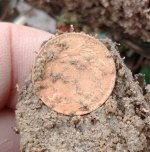46Wheat
Silver Member
- May 23, 2014
- 3,648
- 3,357
- 🥇 Banner finds
- 1
- Detector(s) used
-
Minelab Etrac / Equinox 800 / 8.5x11 DD and 5x8 DD coil /
Garrett ProPointer / Lesche Digger
- Primary Interest:
- All Treasure Hunting
Stopped into a local small bank today that i have never visited to see if they had any Cwr. When I walked into the lobby what to my wondering eyes should appear but a coin machine . My go to dump bank got rid of theirs about 6 months ago and I have been hand rolling since . I opened a savings account and now have access to their machine . They told me they ship 20-30 bags a week to the fed . No limit on the amount I bring and was told they would order coin for me and if I wanted to I could buy bagged coin out of the vault. I told the branch manager who started my account what I did and she thought it was interesting and that they handled most of the local business coins because they are the only ones I'm town with a machine .......... Score
Upvote
0






